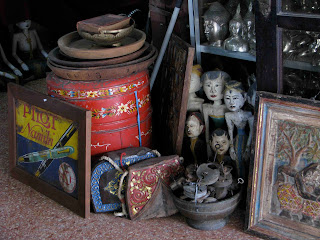WHEN Leila Lopes, Miss Universe 2011, visited Indonesia she acknowledged that she was impressed with Indonesian culture. She expressed her admiration when she visited Living World Alam Sutera in North Serpong district, South Tangerang some time ago. Here the beautiful lady from Angola learned to make batik. “Indonesian batik is very beautiful,” she said.
Leila also tried her hand at making the ancient batik design called Ceplok Gondo Madu originating from Central Java. Accompanied by Putri Indonesia 2011 (Indonesia Lady 2011), Maria Selena, Leila visibly enjoyed making batik although it was the first time she had tried her hand at it.
After trying out her artistic skills, Maria and Leila were shown batik from various regions, such as Cirebon, Garut, Yogyakarta, Surakarta, Lase, Sidoarjo, Madura, Surabaya, Pemalang, Medan, Pekalongan and Bali. Each of them received a batik bolero from Surakarta.
Batik has traveled a long way in Indonesia, starting from ornamental motifs on the walls of ancient temples up to modern designs that have put batik on a par with foreign made haute couture. Batik is a method of making cloth for garments. First, it is a coloring technique that uses wax to prevent the color from spreading on the entire piece of cloth and this technique is called wax-resist dyeing. Second, batik can also be described as a piece of cloth or a dress that is made using the technique mentioned earlier, including the use of specific motifs.
Indonesian batik, embracing its techniques, technology, motifs and the culture of the art, was designated as a Masterpiece of the Oral and Intangible Heritage of Humanity by UNESCO on Oct. 2, 2009.
But of course Indonesia has more to offer than just batik. Indonesia is the largest archipelagic country in the world with 17,508 islands. And, with 1,128 ethnic groups indeed Indonesia is a nation rich in varied cultures, art and crafts.
Each region has its own craft industry, while some regions, such as Yogyakarta and Bali, are virtual handicraft hubs. Here you can easily explore thousands of handicraft and furniture collections.
Indonesian handicrafts are generally made from natural materials, such as wood, rattan, batik, leather and metal that are made into souvenirs or home decorations.
In Indonesia you can find handicrafts throughout the entire archipelago from east to west. In East Nusa Tenggara, for example, besides watching the giant Komodo lizards you can find a rich heritage of traditional woven cloth.
The woven cloth of each tribe in East Nusa Tenggara is passed on from generation to generation to preserve the art. The motif denotes the tribe or the originating island and everyone is proud to wear the woven cloth indicating his or her tribe.
Some tribes, like the East Sumbanese, use animal or human motifs, such as horses, deer, shrimp, dragons, lions, scarecrows, trees and so on while in Central South Timor you will find motifs such as birds, lizards, crocodiles and kaif (hooked diamond). Other areas have flowers and leaves for their motifs while animals are additional.
Unique to Aceh is the nepa, a kind of earthenware vessels or pottery, which are popular among foreign tourists. The word nepa in Gayo language means flattening the clay. You can find most of this type of pottery in Central Aceh regency. The nepa is used by the Gayo people for daily utensils, such as a rice and vegetable cooking pot plus its lid, dishes, cups, jars and so forth.



